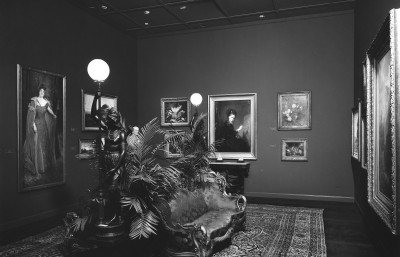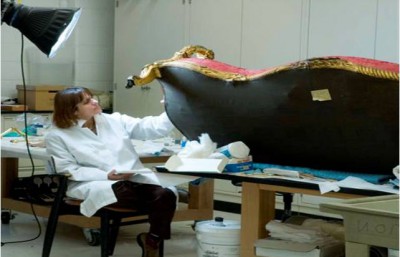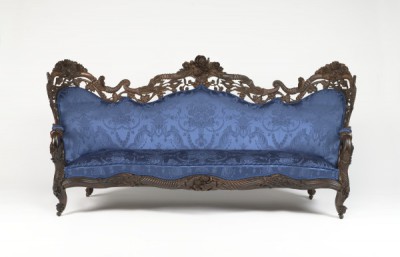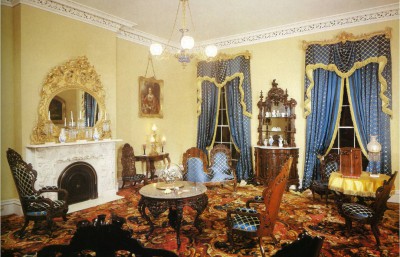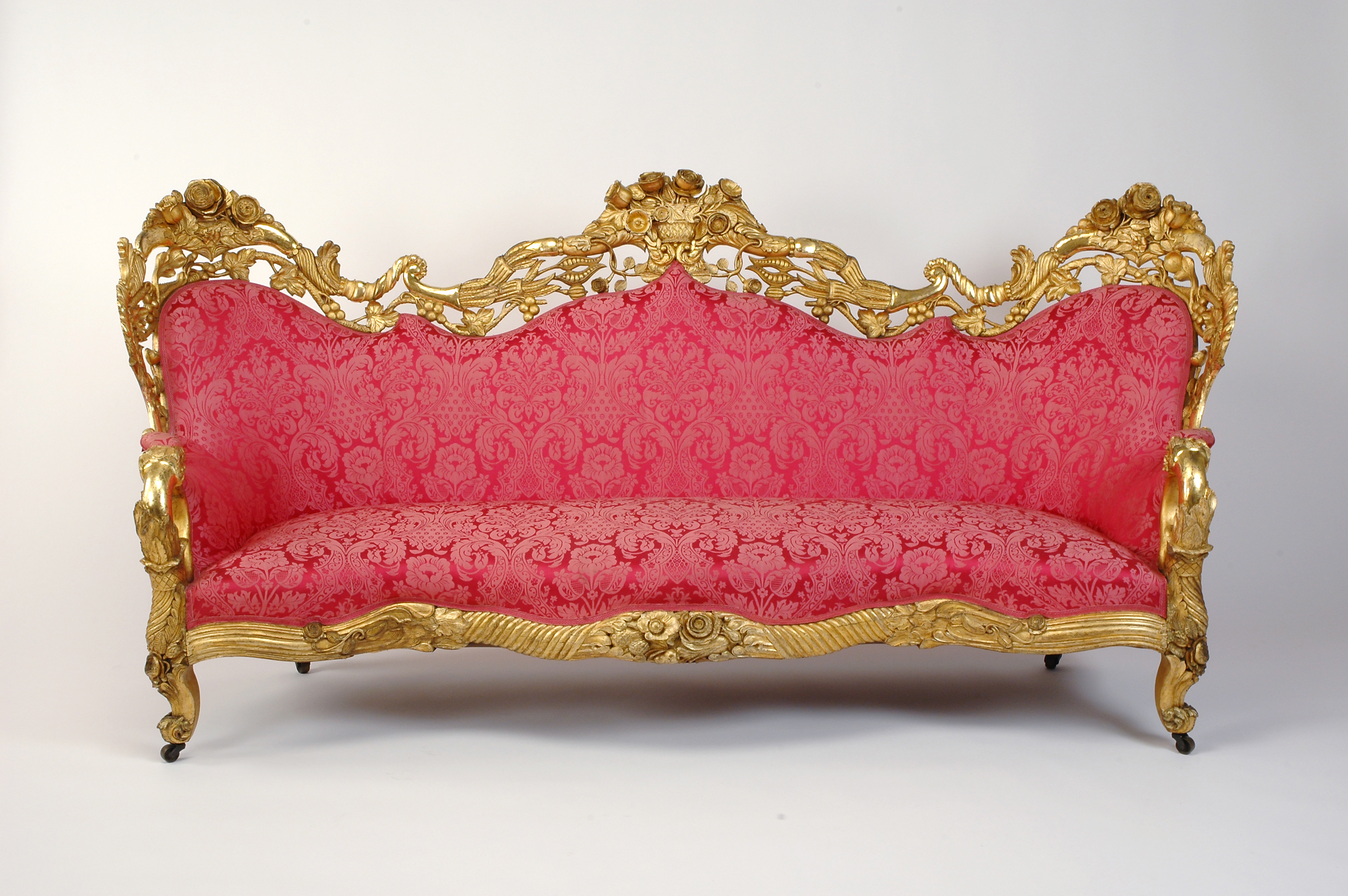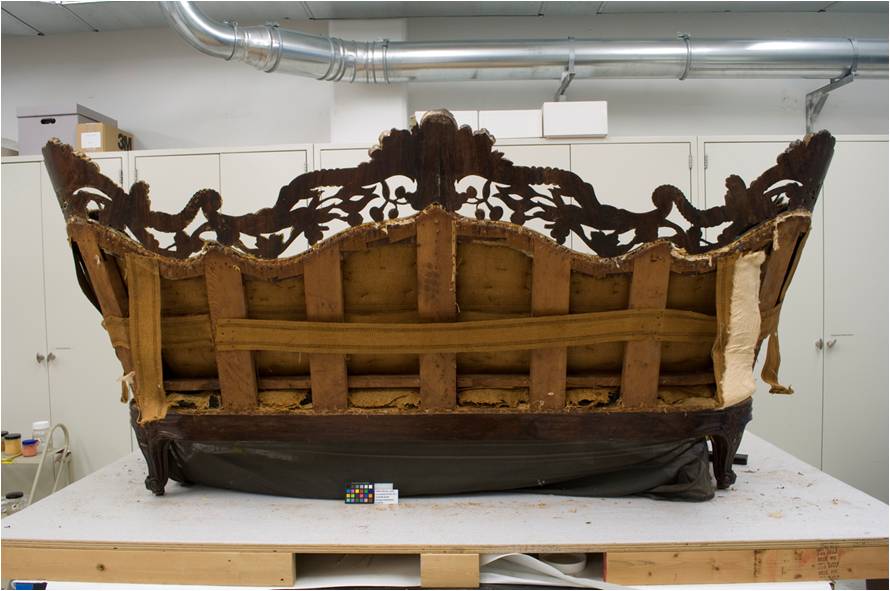Who is Kathy Gillis?
Kathy Gillis worked at The VMFA as the Head of Sculpture and Decorative Arts Conservation. She is now Head of Conservation at the Asian Art Museum, San Francisco. She played a major role in helping with the conservation and installation of the Belter Sofas into the American Art gallery.
Were there multiple theories produced in the conservation of the pieces?
KG: The first theory that the museum had about these pieces is that they had been “rare gilded Belter” furniture – the only known examples. When you see “only known examples” that’s a red flag that something is not right. One curator did believe there was a possibility that these two (and only these two) had been in Belter’s shop and after they were already made, the buyer requested they be gilded. Two things do NOT support that theory – There’s no history of Belter ever gilding furniture, it’s not a service he offered. Second, the gilding occurred over breaks in the carving, indicating they were gilded AFTER they’d been used for awhile and had some damage. Another factor is that gilding is usually done over cheap wood – you wouldn’t waste expensive wood like rosewood (which the sofas are made of) if you were going to cover it up with gilding. The theory we came to agree upon (once the photos from the McLean residence surfaced and microscopy was performed) was that the sofas were built as Belter usually built sofas – with beautifully laminated and carved rosewood and that the gilding was applied around the time the sofas were added to the furnishings of the McLean house, to “update” them, and to get them to match with the other French decorative arts that were used to decorate that property.
As a follow-up from the previous question, what theory proved to be the best and most consistent?
KG: Microscopy and the way the gilding was applied were consistent with the second theory.
How did you deal with anthropogenic threats, especially since the sofas used to be used as gallery seating?
KG: We’ve put the sofa up on a platform, which psychologically should separate it from the benches people see in the galleries as seating furniture. There is also a “Please Do Not Touch” sign on the platform. If someone is old enough to remember them as seating furniture, they’d probably have a hard time climbing up and sitting on them. That said, we DID have a woman climb up so her husband could take a picture of her sitting on the one on view and it was damaged, had to be taken off view (the gold one had a brief stint in the gallery during the work) and repaired. Our best preventive measures are to have the security staff (museum associates) be vigilant about their jobs. Another method is to educate the visitor about the damages to artwork when you touch (or sit on) it, as the “Do Not Touch” carts we developed show. We even used the Belter fabric for the upholstery sample. I personally would like to see more obvious instruction in this to the everyday visitor, like signage at the front door. Right now there is a very brief, tame statement on the back of the visitor map.
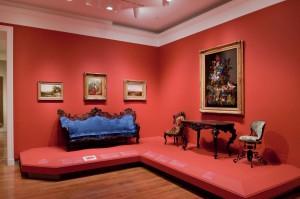
VMFA Galleries 2011 – The James W. and Frances G. McGlothlin American Art Galleries
Photo: Travis Fullerton ©Virginia Museum of Fine Art
What proved to be the biggest challenge within the overall conservation?
KG: Getting the gesso out of the pores of the wood – which was also something I did not anticipate would be so hard. I knew water gilding could be reversed with water, but I had no idea how MUCH water and time would be required to remove the tenacious stuff from the pores of the wood. I also think we thought (hoped) the original varnish layer that existed under the oil gilding would also be still under the water gilding, not realizing it had been stripped off in the process.
How did you decide what fabric to replace the old with?
KG: The fabric was chosen by the Associate Curator of American Painting and Decorative Arts, Susan Rawles. We did look for evidence on the frames that might have told us what originally was on the pieces (sometimes threads are caught in old nails) but the frames had been cleared of all old nails and evidence in one of the previous re-upholstery campaigns, so there were no clues. Susie researched the patterns and materials that were typical of the period and also consulted with an upholstery conservator at the Metropolitan Museum of Art and the local Virginia upholstery conservator, Jennifer Zemanek, who carried out the work.
How long did it take to remove the gold leafing from a top the rosewood?
KG: The gold leaf that was on the oil gilding was easily removed. Actually the gold leaf on the water gilded areas was not a problem either, it was the gesso that is the first coat applied that had been adhered quite tenaciously to the wood pores that was the most difficult to remove. Unfortunately, we didn’t keep good track of the hours it took, but more than four people worked on it at various times over the course of 2 years. This was not NON STOP working 40 hours a week, but I’d say over 100 hours was invested into this process alone. If you have not already done so, I’d suggest you familiarize yourselves with the practice of water gilding vs. oil gilding.
Will the two sofas ever be displayed together? If not, why?
KG: That’s a good question. I was hoping they would immediately be displayed together, but the layout and plans for the 2010 opening of the American Galleries did not leave enough room for both of them. I did discuss the possibility of them being both on display with the curator (Susie Rawles) and she is in favor of doing it, but now that the galleries are in a certain configuration, it’s more of an ordeal to carry out that change. An exhibit of the entire conservation project was planned for the gallery that now holds the Fisher Collection, as it was initially intended as a Focus Gallery for thematic exhibits. When that function changed, a number of exhibits were dropped off the schedule, including Focus Exhibits from the curators. Hopefully one day that will be realized.
Are there specific lighting restrictions for the sofas? What are they?
KG: The most light sensitive part of the sofas is the fabric, since neither the red fabric that was put on in the 70’s or the current new blue fabric are original to the sofa, we did not impose strict light level exposure. Normally for textiles we would not exhibit them in higher than 7 foot-candles (unit for measuring the distance of light output). The wood is a little less light sensitive, especially given that it was protected from light by the gilding! And gold is quite durable, so the one we left gilded has no light restrictions at all. Light exposure is cumulative, so for any artwork, you want to be aware of how much light you are exposing materials to. The lighting in the galleries at VMFA overall is not supposed to exceed 17 foot candles, but that can vary based on what material you have. There’s not a set answer; it is case by case and depends on the history of light exposure an object has had in its lifetime.
How often do the sofas rotate for conservation?
KG: Right now they are not rotating at all. That may change, probably at the curator’s request.
What do you find most interesting about the history of the Belter Sofas?
KG: I find it most interesting that they were updated over the course of their lives; not just with gilding to match the new taste of the gilded age, but with upholstery (there have been at least three different campaigns, probably four) updated to reflect the more current style. The current blue upholstery was chosen as representative of the 1850’s, when they were first made. My theory is that they LIKELY had a similar fabric in 1850, then got a second one in 1905-7. when they were most likely gilded, then another prior to the auction catalog photos in 1948. THAT covering dates prior to the picture Beth [Elizabeth O’Leary, former Curator of American Art, VMFA] found of Mrs. McLean sitting on the sofa with the 1948 upholstery. I don’t remember the date, but it is in the Antiques Magazine article (which I hope the students have had a chance to see as well).
Were there many conservators opposed to removing the gilded surface off the sofa? What was their reasoning?
KG: There was not one conservator I spoke with (and I spoke with about 10) who was opposed to removing the gilding. There was a French conservator who, when seeing the work in progress (and not knowing anything about Belter’s furniture) thought she would not have done the removal, as it was not reversible (something we strive for in our treatments), but after I showed her an un-altered Belter Sofa in the Winterthur Museum’s collection, she changed her opinion. The only person who opposed it initially was a prior curator at VMFA, who felt there may have been a 000.001% chance that these sofas were an anomaly in Belter’s work that might have been gilded at the request of the buyer. Even though he really was convinced after our research and evidence on the sofa that that was highly unlikely. I think he just really liked having two gold sofas. However, as I said in my article (I think) – had we not had TWO sofas, we may have made a different choice, because the gilding IS part of the history and life of these pieces and the fact that we had two allowed us to end up with the best of both worlds. I really do hope they both go on view one day so the complete story can be told.
Because of all the layers of rosewood streamed together and then carved, are there any problems with the carvings shifting or losing their original shape?
KG: The rosewood is pretty stable and it was steamed and dried under pretty strong pressure, so I didn’t really notice any significant shifting of layers. One thing that DID affect the layers was when we were applying so much warm water to get the gesso out of the pores of the wood, some of the glue that held the layers (top) layers together swelled up and came out of the layers. I did remove some of this, but there was plenty of glue left to hold them in place. This would also have been in the flat areas, not the carved areas (which were oil gilded and therefore had no gesso).
Did the gilded surface that was added on later to the sofa do any damage to the rosewood after time?
KG: Not in the oil gilded areas, as it was put on top of the protective varnish coat. The most damage was done when they stripped off this coat to get down to the bare wood to apply the gesso (thus removing original material) and that in turn led to a more difficult process of reversing their gilding.
